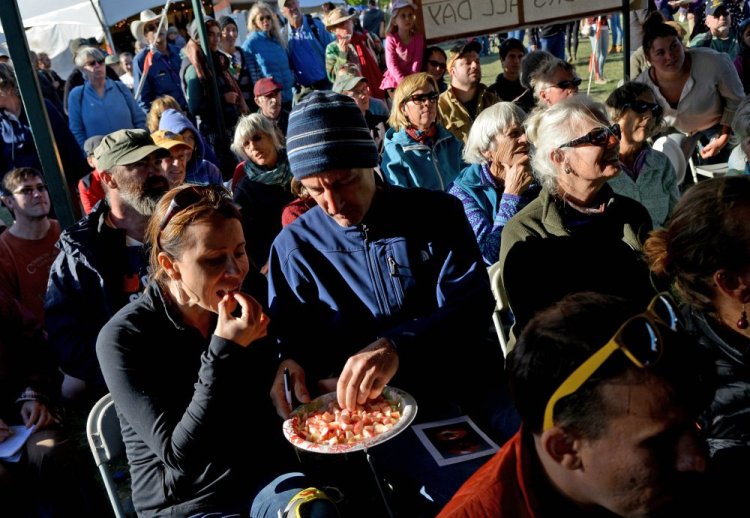UNITY — Ben Cottrell has been wondering what kind of apples grow on the trees outside his old farmhouse in Winterport, so Saturday he brought a handful to the Common Ground Country Fair.
That’s where he found John Bunker, an expert in apple identification whose knowledge kept a steady stream of people stopping by his tent.
Bunker, 66, of Palermo, took one look at the gnarly red and green samples Cottrell showed him and knew instantly.
“They’re not in very good shape, but those are Northern Spy,” Bunker said.
“Yes!” exclaimed Todd Little-Siebold, a history professor at College of the Atlantic who also studies apple identification.

John Bunker speaks during an apple tasting event at the Common Ground Country Fair in Unity on Saturday. Bunker writes the Fedco Tree catalog and is an expert in apple identification. Michael G. Seamans/Morning Sentinel
Little-Siebold said there are more than 1,500 types of apples in Maine. But experts like Bunker and Little-Siebold said many have not been tracked and preserved. The Maine Organic Farmers and Gardeners Association is currently working to build up its heritage apple farm outside its headquarters where the fair is located, Little-Siebold said.
The fair, which concludes Sunday, draws about 60,000 people over three days, and is one of the main ways that new apple varieties are collected and added to the heritage tree farm. But first comes the process of identification.
Bunker, who also authors the Fedco tree catalog and has worked for the company for 35 years, has been identifying apples at the fair for over 20 years.
He started learning to identify apples at a young age by stopping at people’s houses and asking if he could pick the fruit, while growing up in Massachusetts and California. Most times the residents would come out and start talking to him, and he learned identification.
As he got older, he would take a new apple, write the name on it with a marker, and place it in the cup holder of his truck. At stop lights or during construction stops, he would study it.
“After a while you look at an apple and you just know,” he said. “It leaves an impression on your brain.”
Knowing the parts of an apple and the subtleties between different colors also helped Bunker learn to identify an apple.
He said he’s “pretty good,” but at the fair there may be an apple about every half hour or so that he doesn’t know.
When that happens, he asks the apple owner to put it in a paper bag and write their name and phone number. During the year, Bunker will visit hundreds of farms, orchards and individual trees across the state.
So far there are about 300 types of apples in the Maine Heritage Apple Orchard, with plans to grow to 600 or 700 varieties over the next four years, Little-Siebold said.
“It’s not just about nostalgia,” Bunker said. “It’s a connection to the past, but you also can’t buy a good pie apple in the store anymore. There are several dozen out there, we just need to find them. So it’s about preserving them and passing them on to the future.”
Jared Kane, of Milton Mills, N.H., one fairgoer who brought apples to Bunker on Saturday, said that as an aspiring producer of hard cider, he is searching for a good apple. “John has the knowledge that nobody else has,” said Kane, 36. “He really takes his time and researches it, that’s for sure.”
Send questions/comments to the editors.



